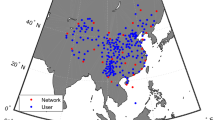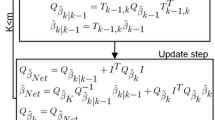Abstract
The integer ambiguity resolution enabled precise point positioning (PPP-RTK) has been proven advantageous in a wide range of applications. The realization of PPP-RTK concerns the isolation of satellite phase biases (SPBs) and other corrections from a network of Global Positioning System (GPS) reference receivers. This is generally based on Kalman filter in order to achieve real-time capability, in which proper modeling of the dynamics of various types of unknowns remains crucial. This paper seeks to gain insight into how to reasonably deal with the dynamic behavior of the estimable receiver phase biases (RPBs). Using dual-frequency GPS data collected at six colocated receivers over days 50–120 of 2015, we analyze the 30-s epoch-by-epoch estimates of L1 and wide-lane (WL) RPBs for each receiver pair. The dynamics observed in these estimates are a combined effect of three factors, namely the random measurement noise, the multipath and the ambient temperature. The first factor can be overcome by turning to a real-time filter and the second by considering the use of a sidereal filtering. The third factor has an effect only on the WL, and this effect appears to be linear. After accounting for these three factors, the low-pass-filtered, sidereal-filtered, epoch-by-epoch estimates of L1 RPBs follow a random walk process, whereas those of WL RPBs are constant over time. Properly modeling the dynamics of RPBs is vital, as it ensures the best convergence of the Kalman-filtered, between-satellite single-differenced SPB estimates to their correct values and, in turn, shortens the time-to-first-fix at user side.
















Similar content being viewed by others
References
Chen G, Zhao Q (2014) Near-field surface displacement and permanent deformation induced by the Alaska Mw 7.5 earthquake determined by high-rate real-time ambiguity-fixed PPP solutions. Chin Sci Bull 59(34):4781–4789
Collins P, Bisnath S, Lahaye F, Héroux P (2010) Undifferenced GPS ambiguity resolution using the decoupled clock model and ambiguity datum fixing. Navigation 57(2):123–135
Gao Y, Shen X (2002) A new method for carrier-phase-based precise point positioning. Navigation 49(2):109–116
Ge M, Gendt G, Ma Rothacher, Shi C, Liu J (2008) Resolution of GPS carrier-phase ambiguities in precise point positioning (PPP) with daily observations. J Geodesy 82(7):389–399
Geng J, Teferle FN, Meng X, Dodson A (2010) Kinematic precise point positioning at remote marine platforms. GPS Solut 14(4):343–350
Geng J, Teferle FN, Meng X, Dodson A (2011) Towards PPP-RTK: ambiguity resolution in real-time precise point positioning. Adv Space Res 47(10):1664–1673
Geng J, Teferle FN, Shi C, Meng X, Dodson A, Liu J (2009) Ambiguity resolution in precise point positioning with hourly data. GPS Solut 13(4):263–270
Kouba J, Héroux P (2001) Precise point positioning using IGS orbit and clock products. GPS Solut 5(2):12–28
Laurichesse D, Mercier F, Berthias JP, Broca P, Cerri L (2009) Integer ambiguity resolution on undifferenced GPS phase measurements and its application to PPP and satellite precise orbit determination. Navigation 56(2):135–149
Leick A, Rapoport L, Tatarnikov D (2015) GPS satellite surveying. Wiley, New York
Li X, Dick G, Ge M, Heise S, Wickert J, Bender M (2014) Real-time GPS sensing of atmospheric water vapor: precise point positioning with orbit, clock, and phase delay corrections. Geophys Res Lett 41(10):3615–3621
Li X et al (2013) Real-time high-rate co-seismic displacement from ambiguity-fixed precise point positioning: application to earthquake early warning. Geophys Res Lett 40(2):295–300
Li X, Zhang X, Ge M (2011) Regional reference network augmented precise point positioning for instantaneous ambiguity resolution. J Geodesy 85(3):151–158
Lo AW, MacKinlay AC (1988) Stock market prices do not follow random walks: evidence from a simple specification test. Rev Financ Stud 1(1):41–66
Odijk D, Zhang B, Khodabandeh A, Odolinski R, Teunissen PJ (2016) On the estimability of parameters in undifferenced, uncombined GNSS network and PPP-RTK user models by means of \(\cal{S} \)-system theory. J Geodesy 90(1):15–44
Petit G, Kanj A, Loyer S, Delporte J, Mercier F, Perosanz F (2015) \(1\times 10^{-16}\) frequency transfer by GPS PPP with integer ambiguity resolution. Metrologia 52(2):301–309
Plumb J, Larson KM, White J, Powers E (2005) Absolute calibration of a geodetic time transfer system. IEEE Trans Ultrason Ferroelectr Freq Control 52(11):1904–1911
Sardon E, Rius A, Zarraoa N (1994) Estimation of the transmitter and receiver differential biases and the ionospheric total electron content from Global Positioning System observations. Radio Sci 29(3):577–586
Teunissen PJG (1985) Zero order design: generalized inverses, adjustment, the datum problem and S-transformations. In: Grafarend EW, Sanso F (eds) Optimization and design of geodetic networks. Springer, Berlin, Heidelberg, New York, Tokyo, pp 11–55
Teunissen P, De Jonge P, Tiberius C (1997) The least-squares ambiguity decorrelation adjustment: its performance on short GPS baselines and short observation spans. J Geodesy 71(10):589–602
Teunissen P, Khodabandeh A (2015) Review and principles of PPP-RTK methods. J Geodesy 89(3):217–240
Teunissen P (1995) The least-squares ambiguity decorrelation adjustment: a method for fast GPS integer ambiguity estimation. J Geodesy 70(1–2):65–82
Teunissen P (2012) A-PPP: array-aided precise point positioning with global navigation satellite systems. IEEE Trans Signal Process 60(6):2870–2881
Teunissen P, Odijk D, Zhang B (2010) PPP-RTK: results of CORS network-based PPP with integer ambiguity resolution. J Aeronaut Astronaut Aviat Ser A 42(4):223–230
Teunissen P, Verhagen S (2009) The GNSS ambiguity ratio-test revisited: a better way of using it. Survey Rev 41(312):138–151
Zhang B (2016) Three methods to retrieve slant total electron content measurements from ground-based GPS receivers and performance assessment. Radio Sci 51(7):972–988
Zhang B, Teunissen P (2015) Characterization of multi-GNSS between-receiver differential code biases using zero and short baselines. Sci Bull 60(21):1840–1849
Zhang B, Teunissen PJG, Yuan Y (2017) On the short-term temporal variations of GNSS receiver differential phase biases. J Geodesy 91(5):563–572
Zumberge J, Heflin M, Jefferson D, Watkins M, Webb FH (1997) Precise point positioning for the efficient and robust analysis of GPS data from large networks. J Geophys Res Solid Earth 102(B3):5005–5017
Acknowledgements
This work is supported by the Chinese Academy of Sciences (CAS) Pioneer Hundred Talents Program, the National Natural Science Foundation of China (Nos. 41604031, 41774042, 41574015), the National key Research Program of China “Collaborative Precision Positioning Project” (No. 2016YFB0501900) and the Natural Science Foundation of Jiangxi Province (No. 20161BAB213087). The GPS data are available from Curtin University’s local data center (http://saegnss2.curtin.edu.au/ldc/). Our special thanks go to Professor Peter Teunissen for his thoughtful suggestions and extensive discussions. The third author acknowledges LU JIAXI International team program supported by the K.C. Wong Education Foundation and CAS.
Author information
Authors and Affiliations
Corresponding author
Rights and permissions
About this article
Cite this article
Zhang, B., Liu, T. & Yuan, Y. GPS receiver phase biases estimable in PPP-RTK networks: dynamic characterization and impact analysis. J Geod 92, 659–674 (2018). https://doi.org/10.1007/s00190-017-1085-z
Received:
Accepted:
Published:
Issue Date:
DOI: https://doi.org/10.1007/s00190-017-1085-z




